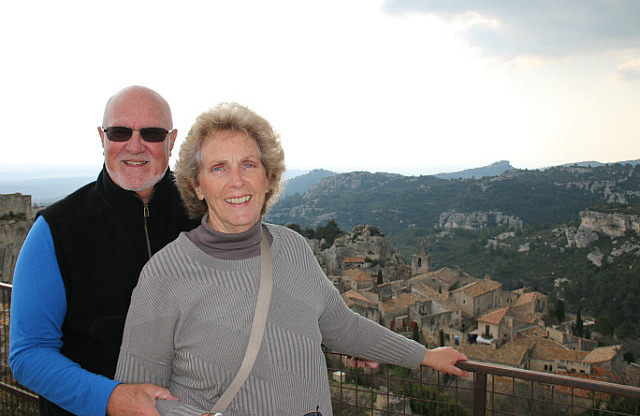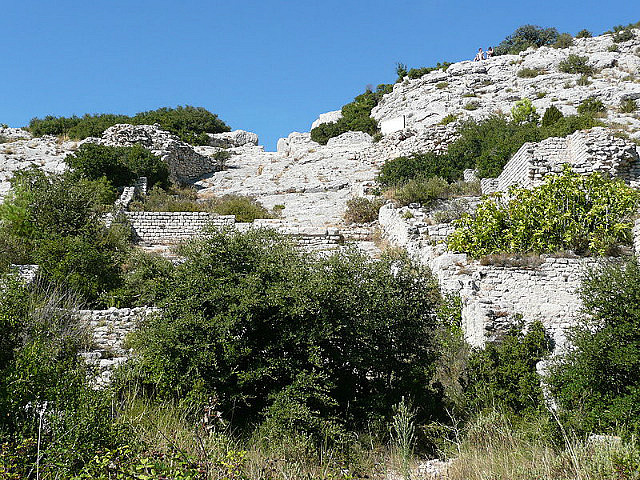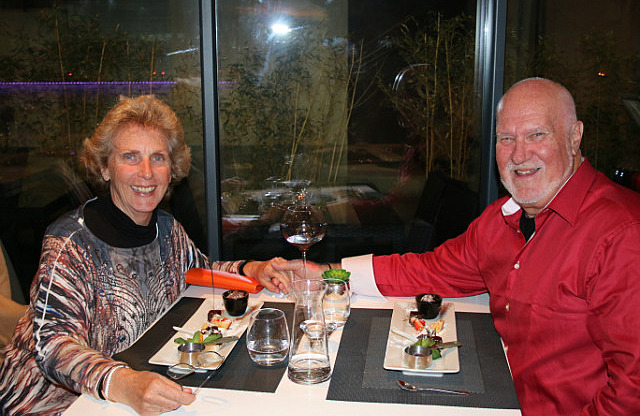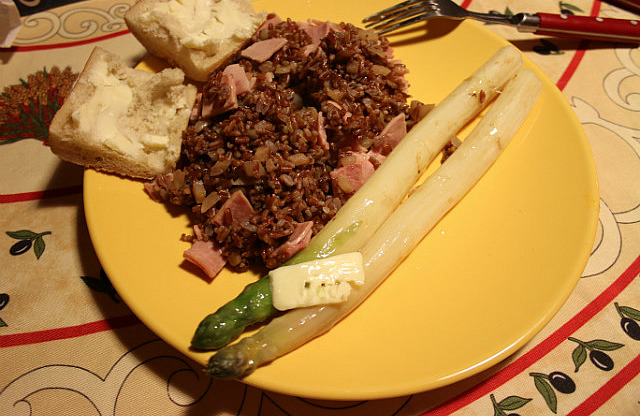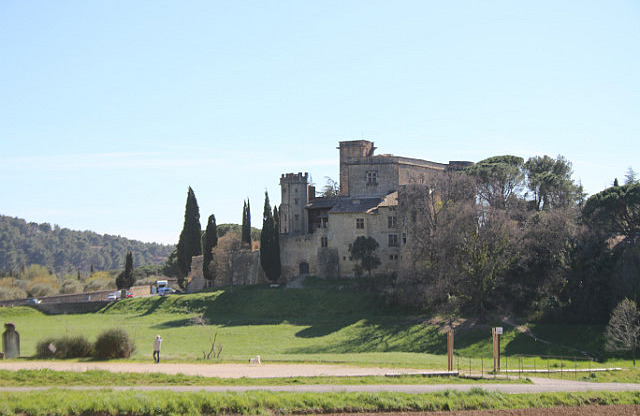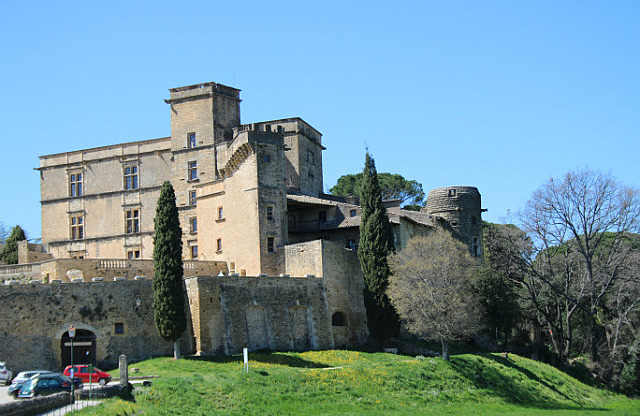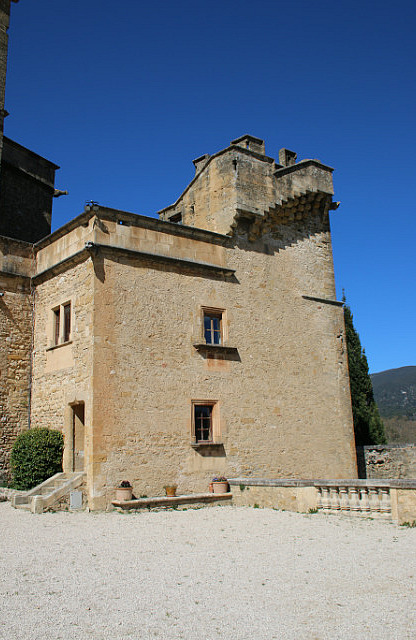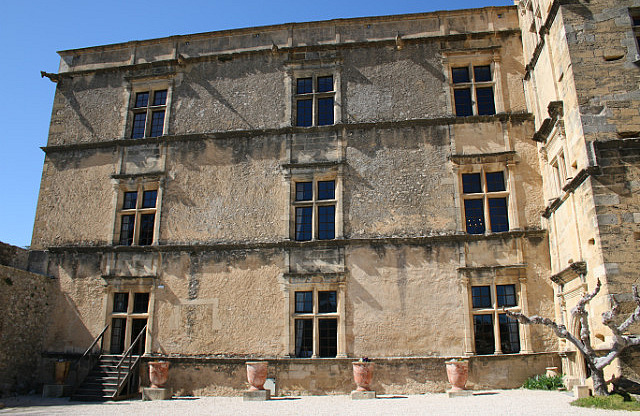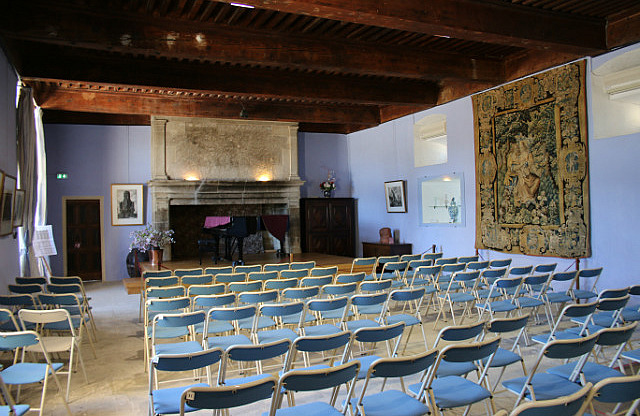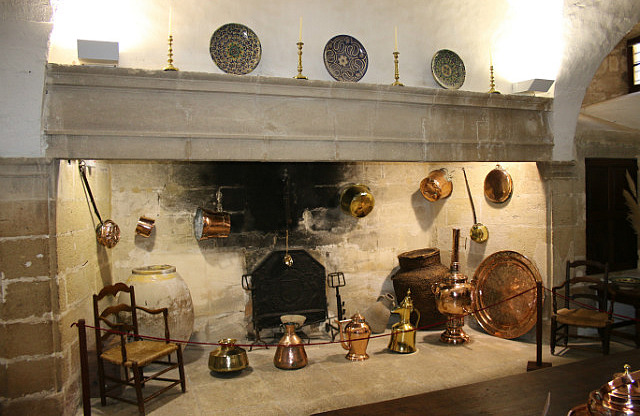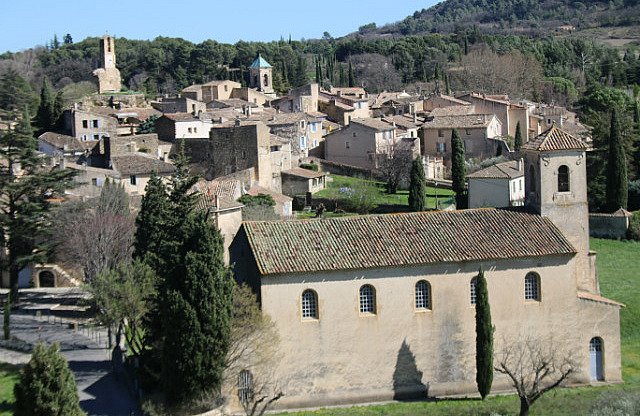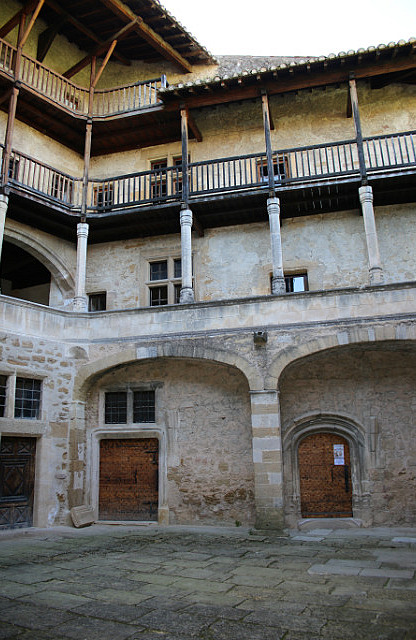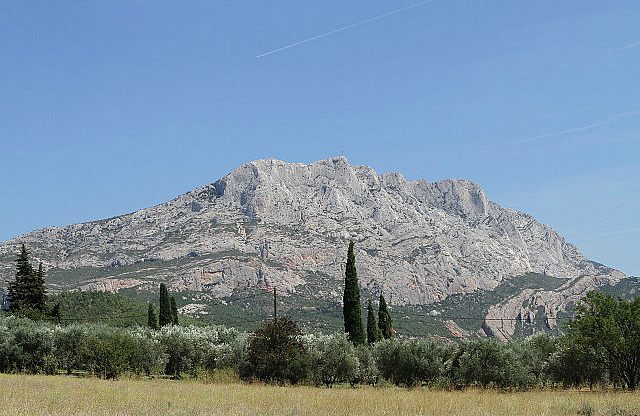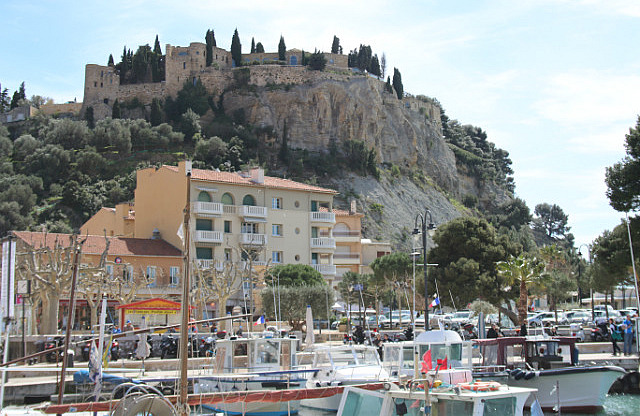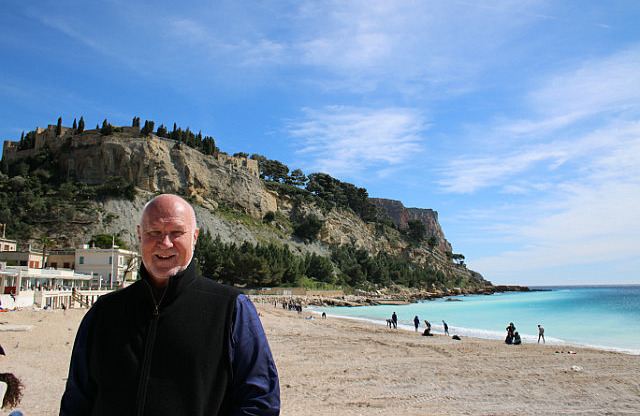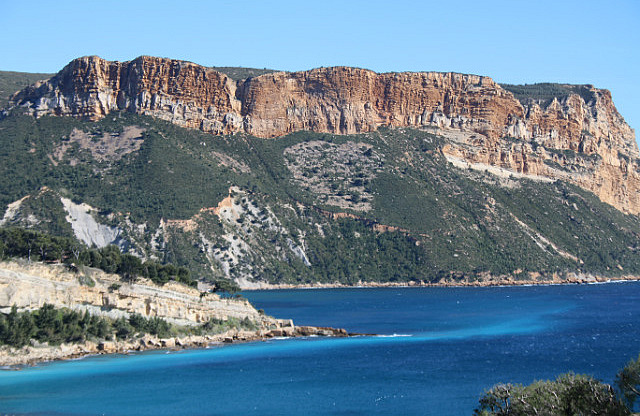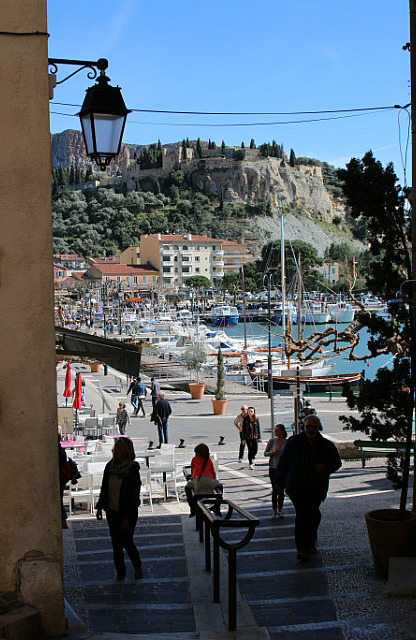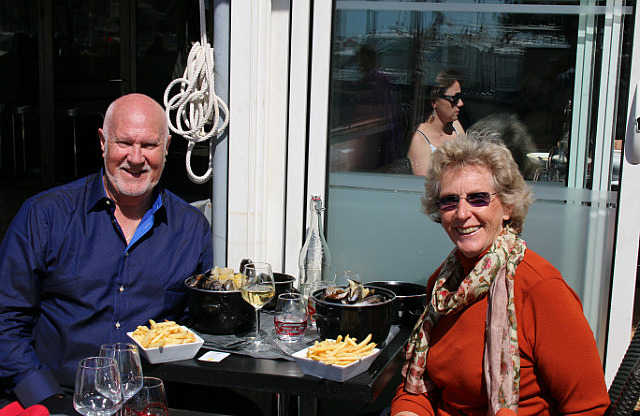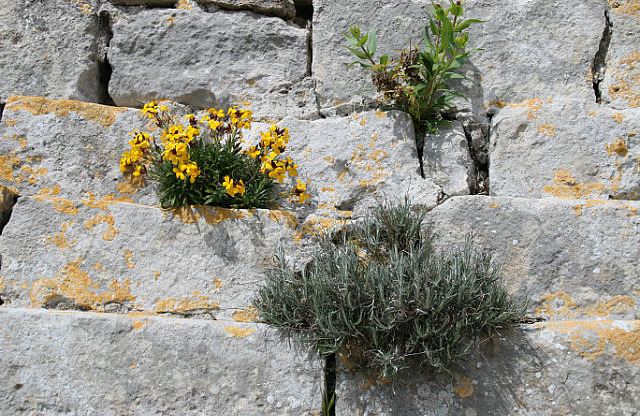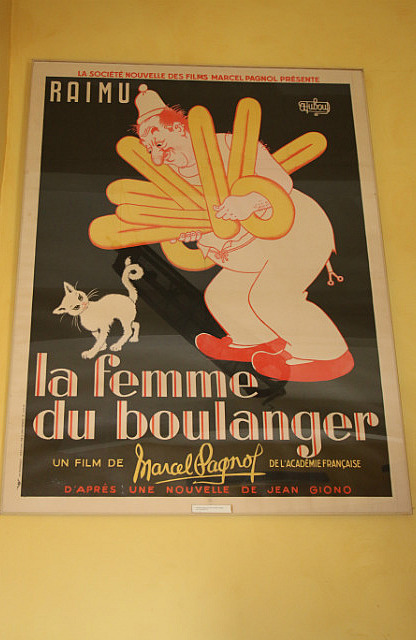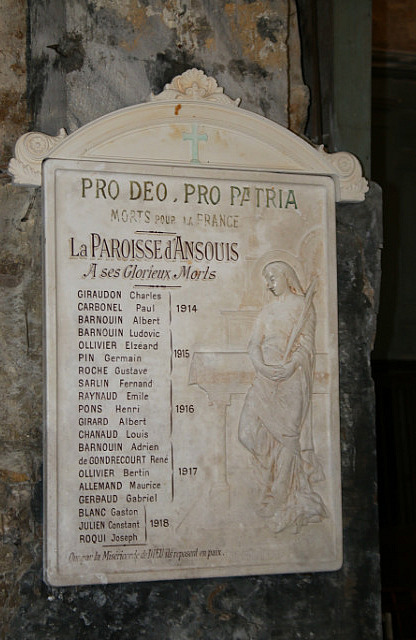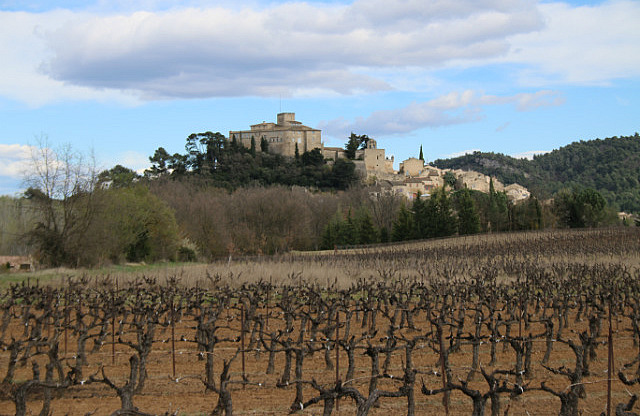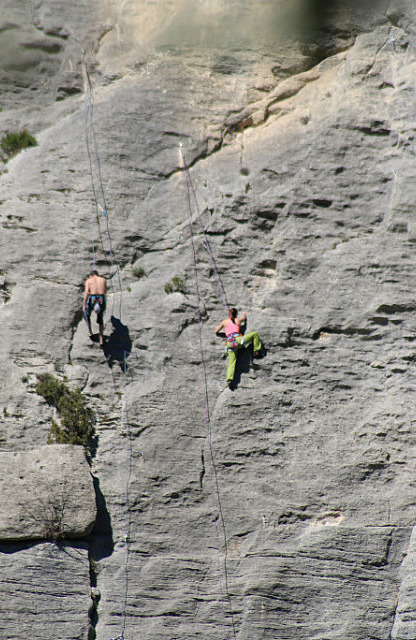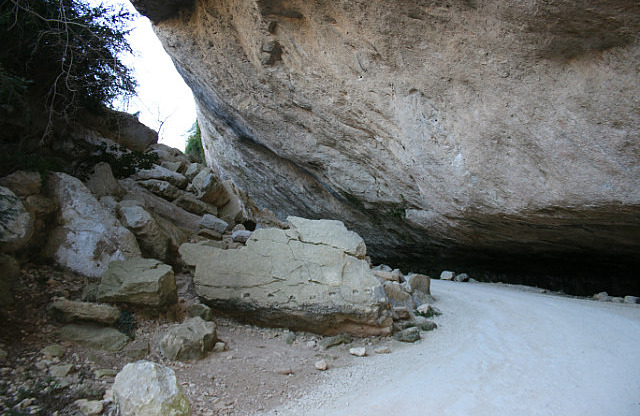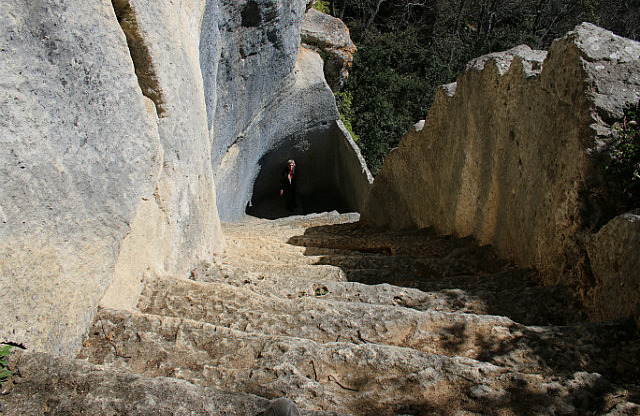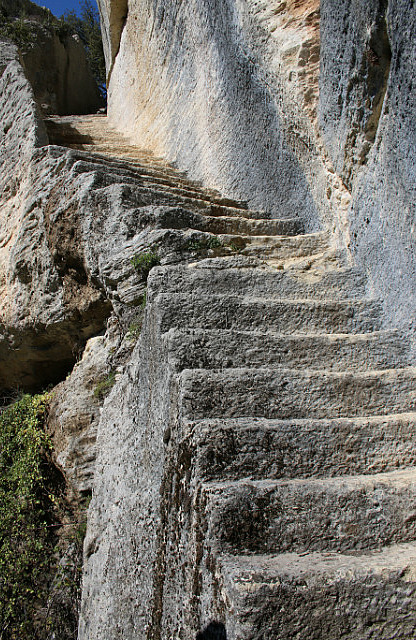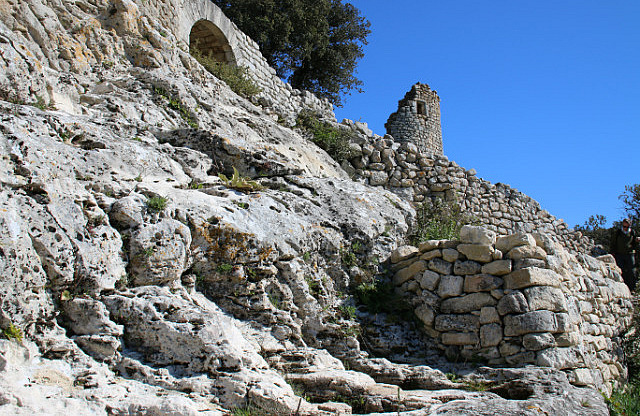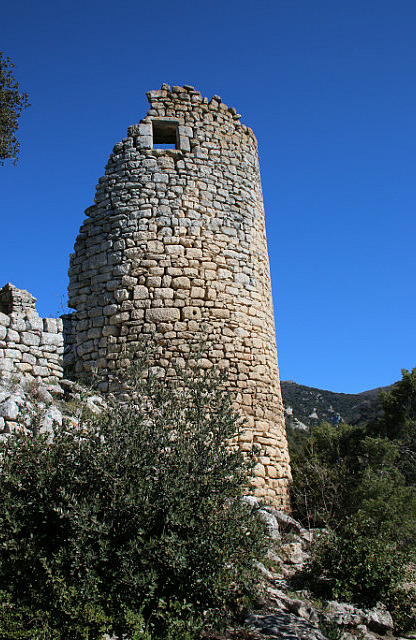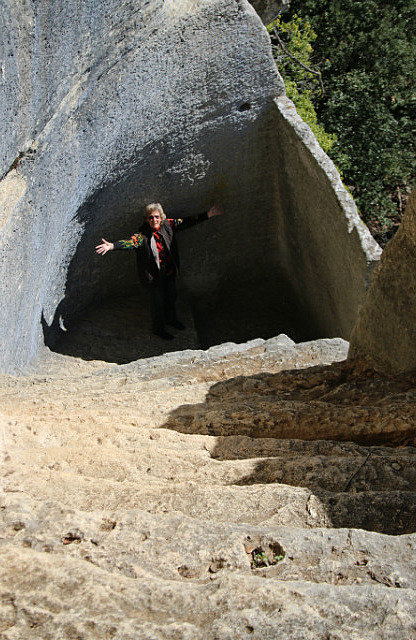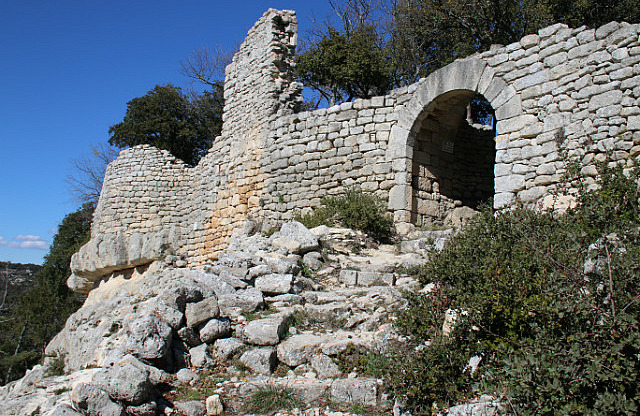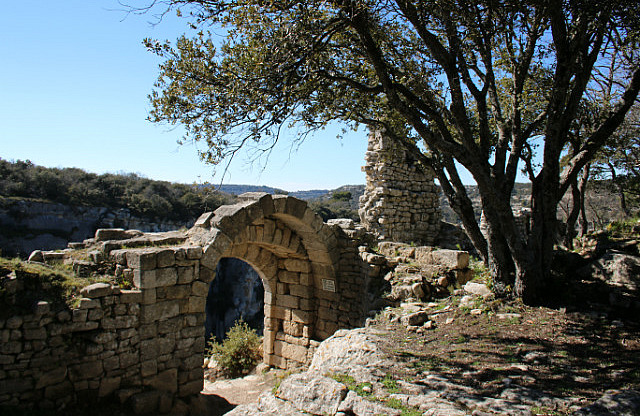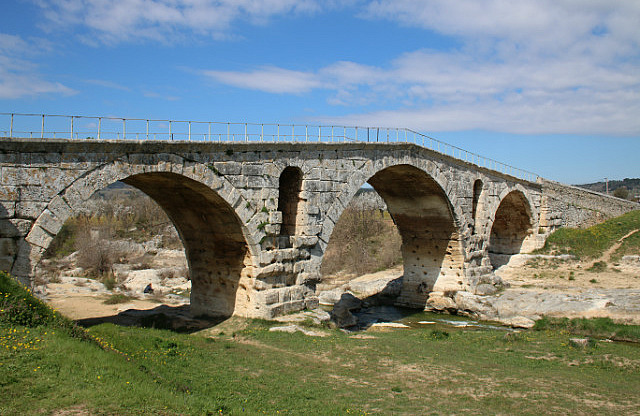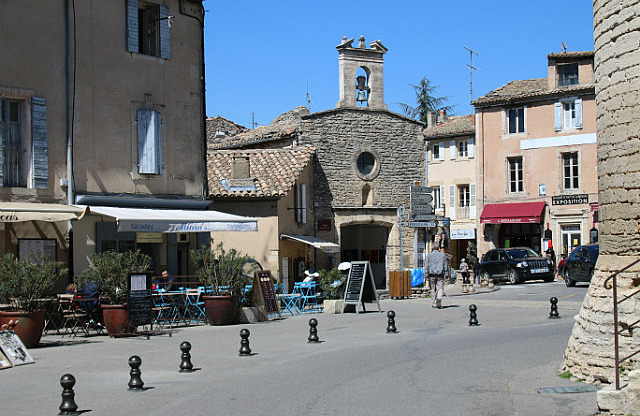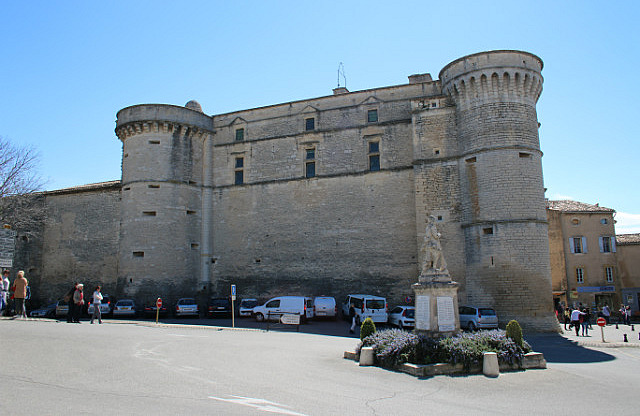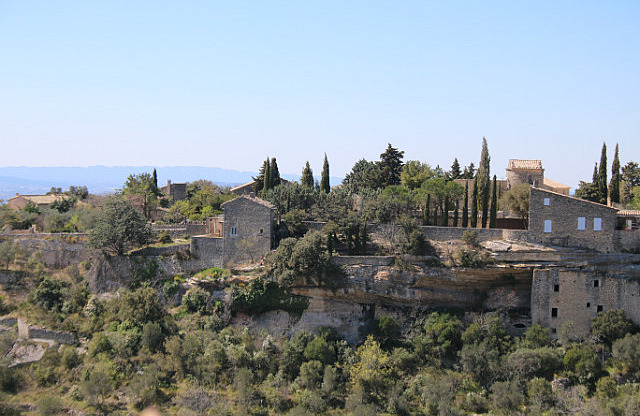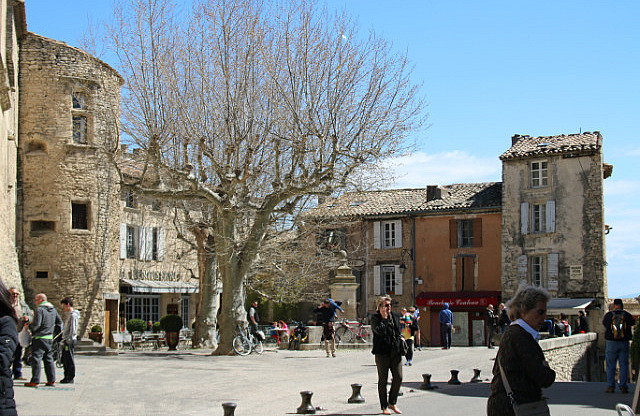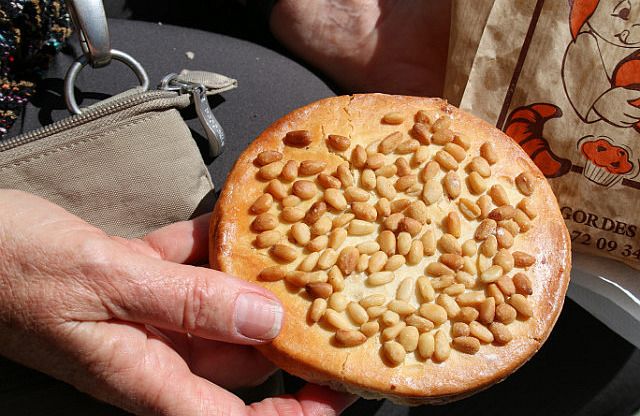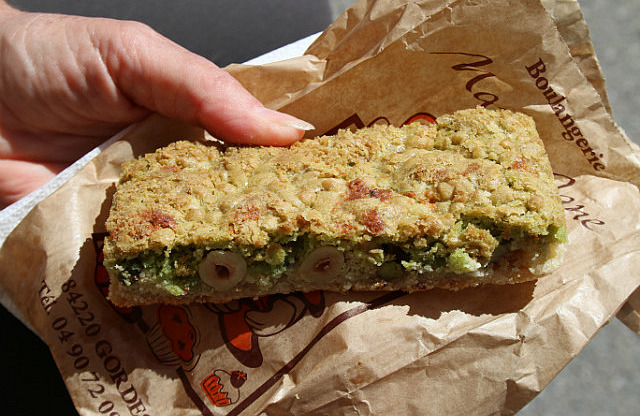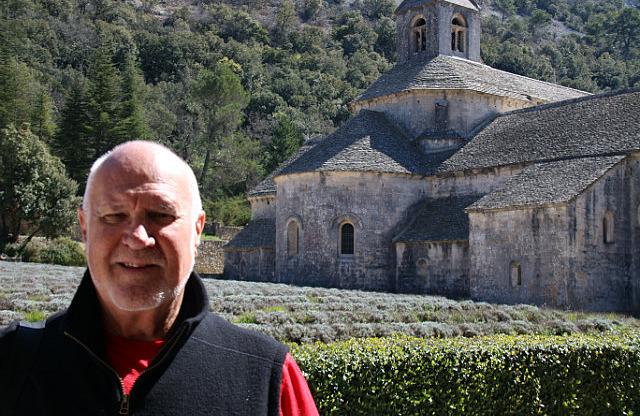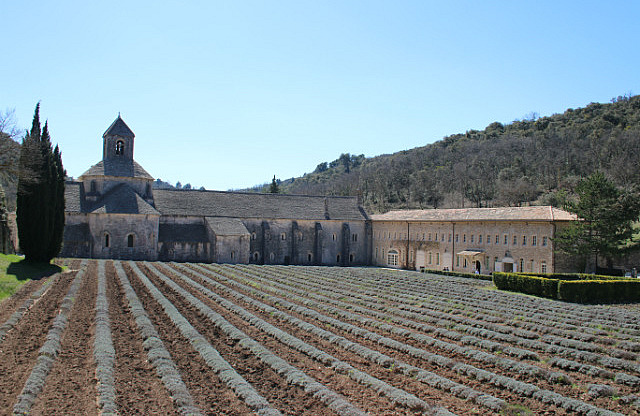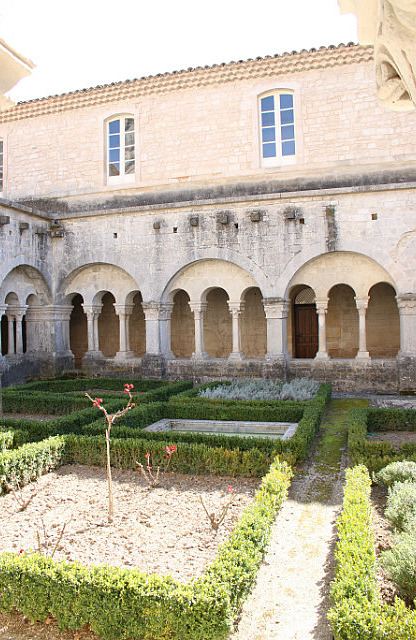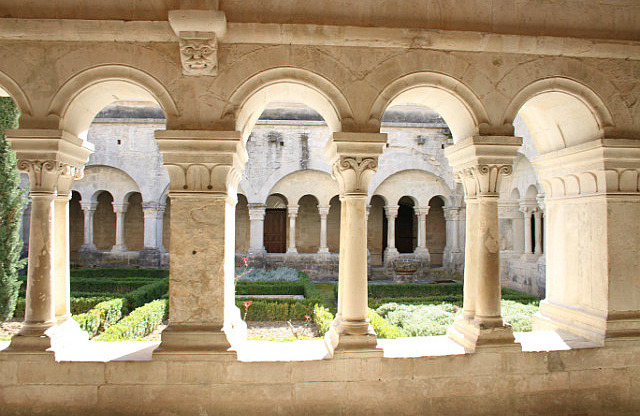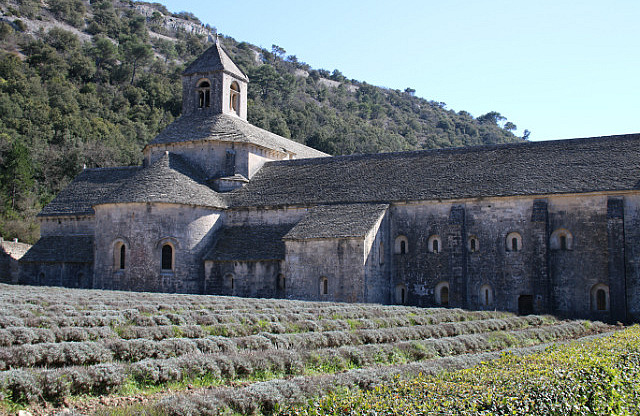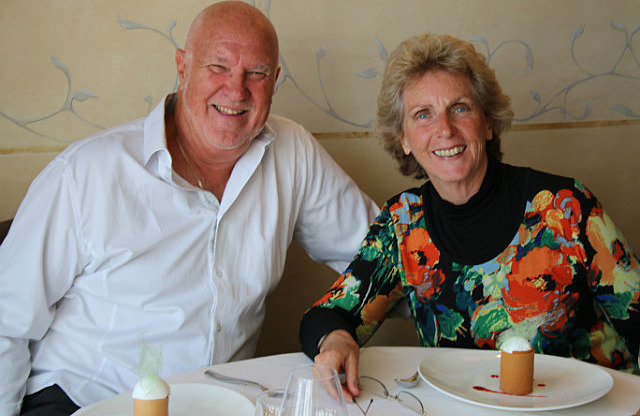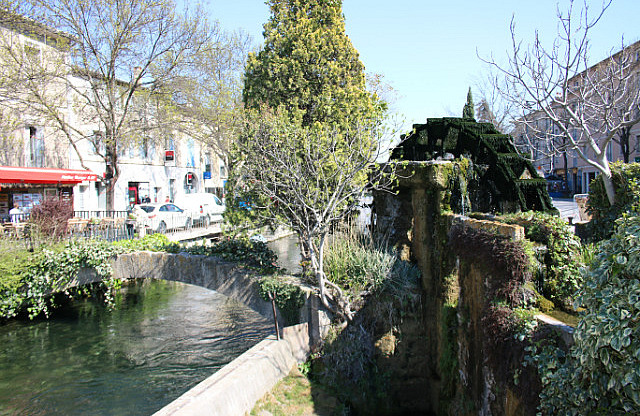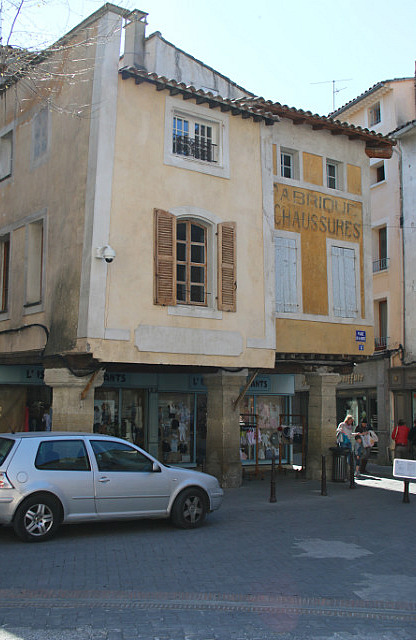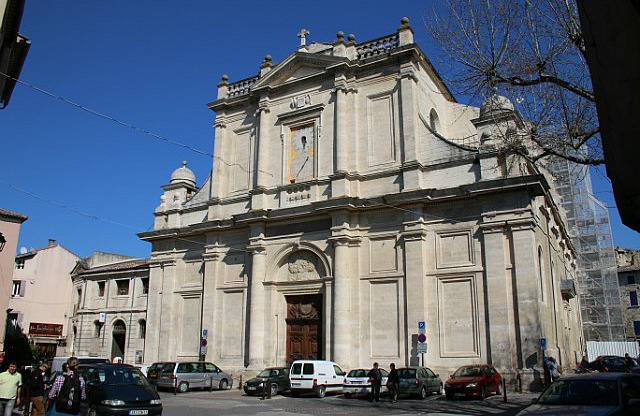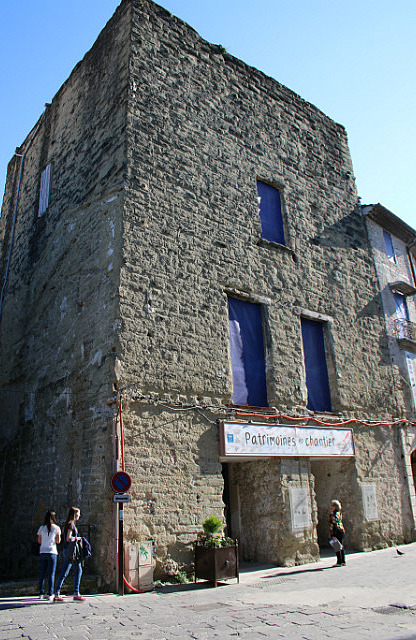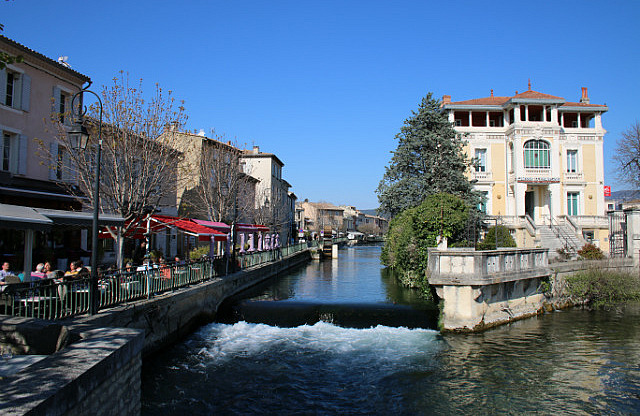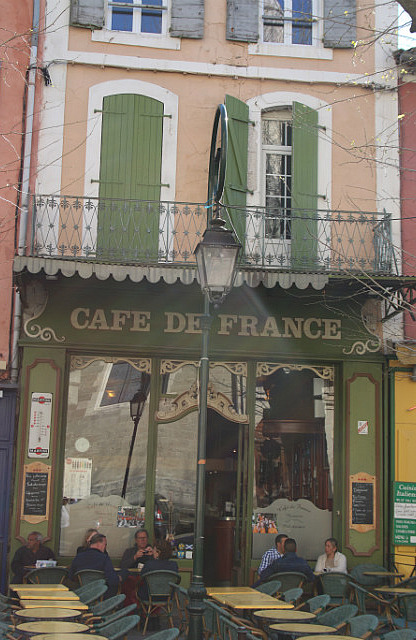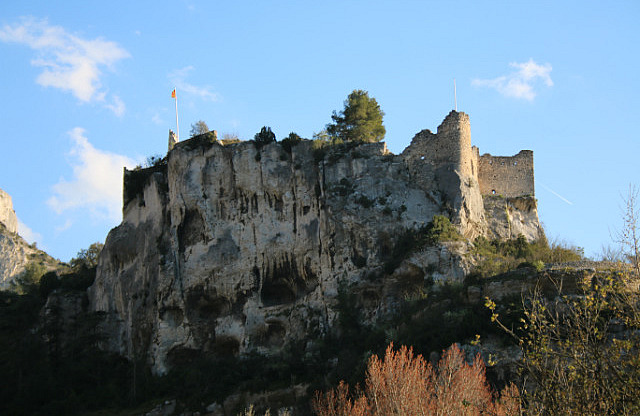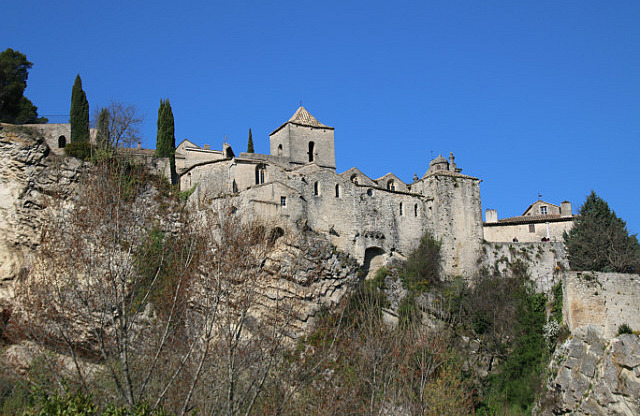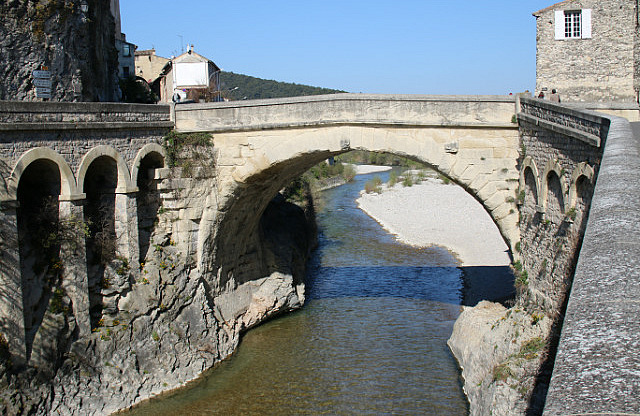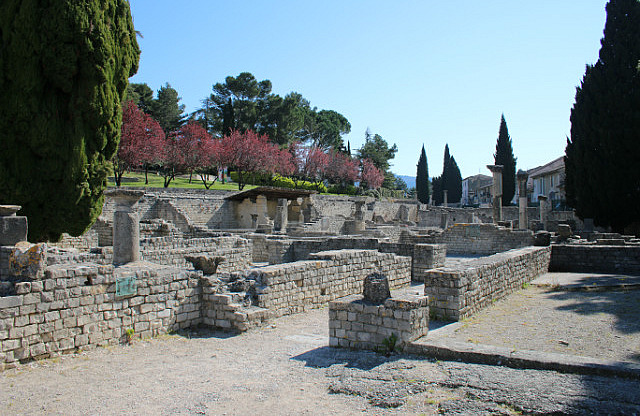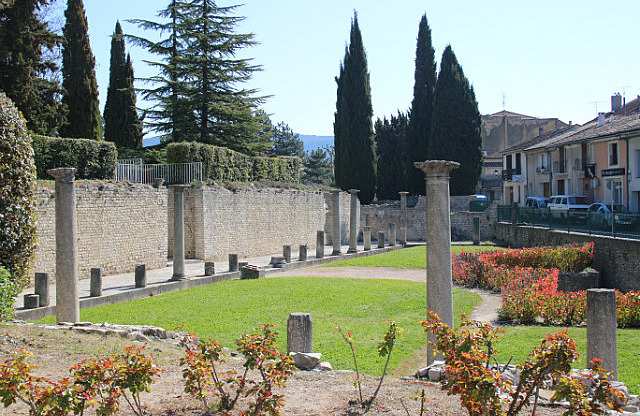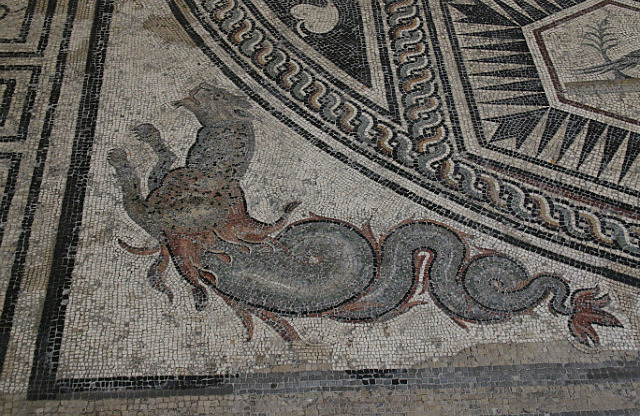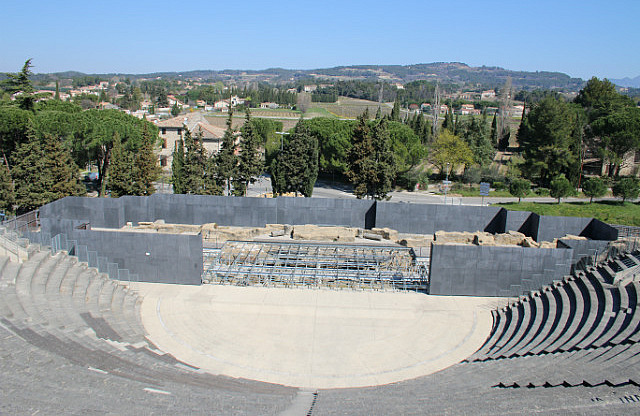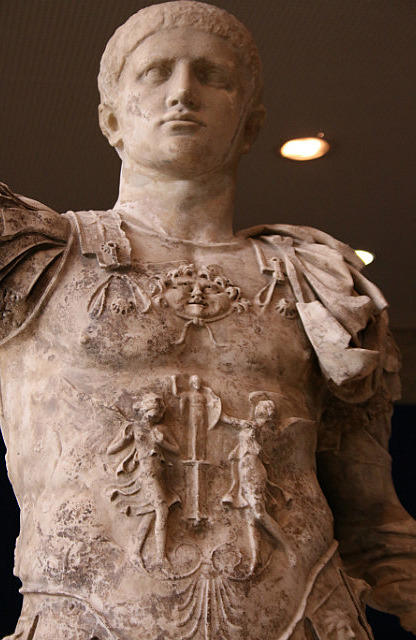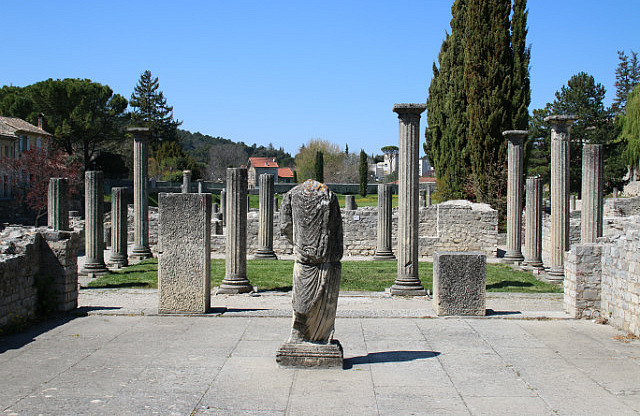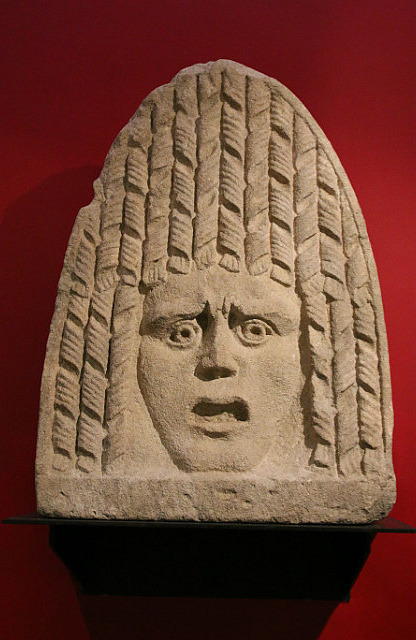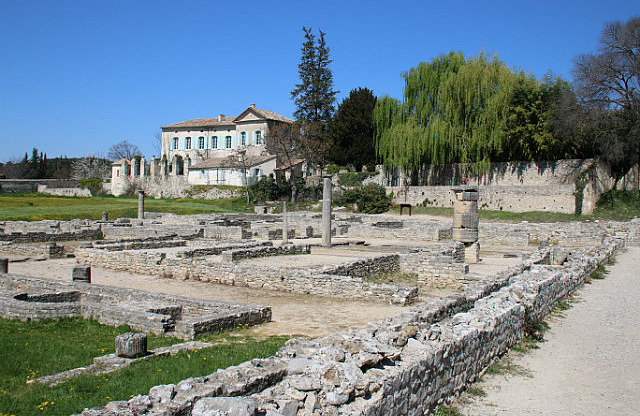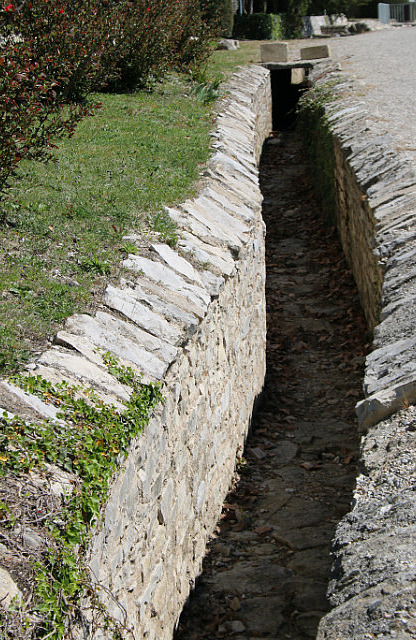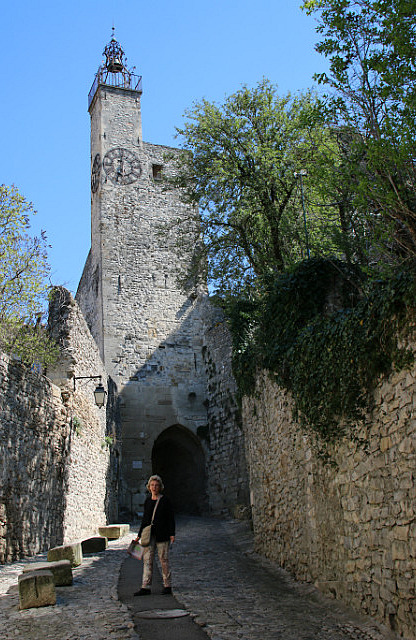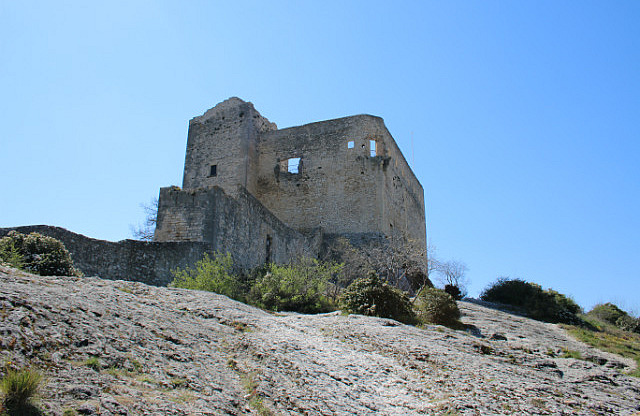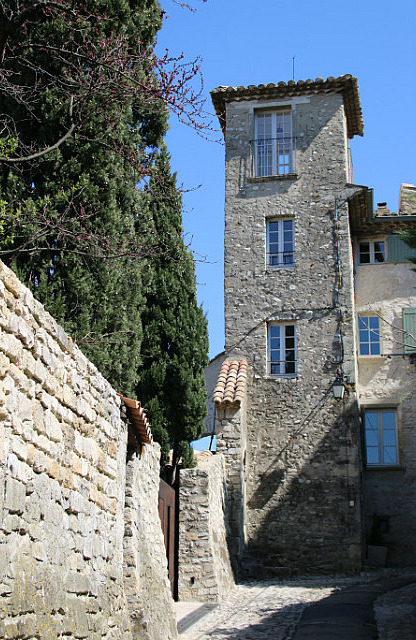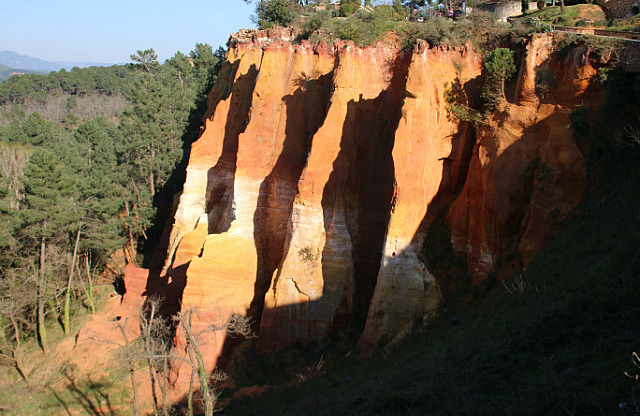Vaison-la Romaine
Apr 8, 2015
For the first time this holiday, we had to set the alarm on my phone to make sure we could get away by 8.30 for a 1.5 hour drive north to Vaison-la Romaine. Thankfully this was an uneventful drive because Tom took us across country on a "yellow" road and then on the motorway north before a leisurely cross county last 20 minutes through pretty farming countryside.
We arrived in the carpark where there were only a dozen or so cars at around 10.15 and with no public toilets in sight, went looking for a bar/cafe on the "Roman" side of the river. Gotta say at this point that we have never come across as many "hole in the floor" toilets as we have in the last three weeks. For a country that is so fastidious as to have a bidet sitting next to the toilet in many or most homes, why do they then revert to squatting in public toilets. Many have been particularly gross.
The "Roman" side of town is the side that is spread along the river on the flat plain below the mountain on which the "medieval" town is located. Give me Roman anytime over medieval and particularly when there are the remains of vast villas and theatres.
After Cafe and Thé, we went in search of the usual; the Tourist Info. Office. A town map lead us to the archaeological site entrance 100 m away and with a 24 hour ticket we were set. The Roman town is the largest in France and covers 150 acres, most of it still under the existing lower town, and 17 acres have been excavated.
Just inside the entrance to the first site "Puymin", is “Maison A l'Apollon Laure”. It’s 2,000 m2 and probably larger as extensions are believed to be under the street and houses across the road. Nevertheless, the 2,000 that is visible raises a number of questions. Well it did for me and I made it an important issue for Ches as well. No simple sightseeing, you’ve gotta consider the big questions, like:
If the owners of these massive “villas” were locals who had become “romanised”, how did they know to build to this standard design of “villas”. I’ve watched most “Time Team” episodes at least once and have no problem watching the ones about roman villas a second time. Almost every time, they are of a similar design:
http://www.crystalinks.com/romebuilding s.html scroll down to “Villa”
That lets you off lightly.
Was there a firm of architects in Rome who provided plans for the building of villas all over the Roman empire? Did builders move north as the empire expanded, picking up contracts for the “nouveau riche-would be Romans”
This villa and another 4 others excavated in the “La Villasse” site across the road are basically in a line facing the river. You can’t see that now as there are houses built in the 1600’s over anything between the river and the archaeological site. All have features such as central courtyards with fountains, dining rooms that open onto the courtyards, walkways around the courtyards with columns supporting the roof, reception rooms, offices, bedrooms (usually in an upstairs wing), latrines and baths.
We stood on the path above “Maison A l’Apollon Laure” and located all the rooms and their purposes. The photo included here probably won’t help you as much as it helps us.
This could be painful for everyone so move along if the mood takes you or look at the links.
http://www.vaison-la-romaine.com/spip.p hp?article390
We worked our way around the site, to the Theatre. Here I embarrassed myself in a major way. I assumed that it had survived intact for 2,000 years. Particularly when I read that it was renovated 300 years after it was built. I marvelled at the stonework at the back of the terraced seating, the seating itself and the remnants of the stage itself. I got everything wrong. The major citizens didn’t sit up the back but down the front. The back was for the plebs; the same as it is today. The whole place was a wreck till restored in the last century, all the seating replaced as the originals had been carted off to build houses over the following 1,500 years. They have used materials dug out of the site such as the columns on the stage and the structure high up at the back, however it’s a reconstruction. Still impressive.
I raise the question. Given this was a town developed by the local celtic peoples who were Romanised, who became the leaders? Was it the most powerful ex-warriors? Was it the best merchants who could contribute to the commerce of Rome (they were trading produce throughout the Mediterranean from all over Gaul through Masalia, Massalia or Massilia the current Marseille which was then a Greek port that the Romans were protecting ?
Unlike most Roman cities throughout Gaul, this wasn’t established by ex-legionnaires. Rome’s success was largely built on honoring the retirement plans of its soldiers. After serving for 16 or 20+ years, they were entitled to land in the territories they had helped capture and in the cast of Orange, just 30km away, it was established by Julius Caesars troops, 8 years after his assassination.
OK, OK, we spent a lot of time looking at archaeological digs, climbing all over the Medieval town built on the hill across the river and fighting off local cats who wanted our lunch.
By this stage, Ches had destroyed her hips again. She fears she is back to where she was a year ago. We abandoned any thought of visiting the other towns in the area and asked Tom to take us to Roussillon which is near home. This is the town with the ochre mines that was swamped by tourists on Monday.
Here we had a major falling out and Tom set Ches and I against each other. On leaving Vaison-la-Romaine, we would pass by Mont Ventoux. That’s the one high enough to have snow but also totally bare so that the limestone which is pure while looks like snow. I figured the w*** would take us via mountain peaks and gorges so set him to travel via Carpentras. This should be far enough west that he would have to take the “yellow” and perhaps the occasional “green” roads.
Ches asked what was the quickest route according to Tom and I responded the one that avoided Carpentras. OK, OK again, we elected to try to keep him under control. To cut a long, long argument really short, Tom only used “white” roads. They are the ones that go through country no tourist ever visits, through towns rather than around them, and on roads only wide enough for one car. The only benefit is that there are no other cars, or only an occasional one.
Just when my patience had completely worn out, he took us deep into a ravine (that’s worse than a gorge or canyon). The road was so bad it was more patches than original road and was one car width wide. Eventually we began to climb. Our ear drums popped. Get the idea? Eventually we found ourselves on top of the mountain above Gorde. remember how he handled Gorde on Monday?. Rather than let him take us through the town, we took the alternative direct route to Roussillon . Again it involved steep and twisting roads however we did have a cliff face the size of Uluru to look at all the way down.
On entering town, we found a parking spot, put in 1E to cover the 20 minutes till 6.00 pm when it would be free parking and then discovered why it is free after 6.00. We walked out the 1km to the entrance and found that it was already closed for the day.
Now, this day has to have a happy ending. We decided to revisit La Flambee. This time we would have the world famous Pain de Chevre, but not the litre of red that sank us last time.
Pain de Chevre as it turned out was and is, a very thin pizza base with goats cheese, a little crème fraiche and herbs (we think rosemary), spread on half of it, folded over like a calzone and then cooked in the pizza oven so that it puffs up. Wonderful.
The duck was also great and we both had Ile Flottante for desert. Ches had been so disappointed in their Crème Caramel last time she didn’t have any expectations. It was wonderful.
From here on in, it’s not for the faint hearted and ou might want to call it quits. It’s translated from the French by Monsieur Google. If you go to the bottom of the page where their are extra photographs, you can click on the "Slideshow" button and see all of them much larger than in the blog itself.
The Roman Bridge The Gallo-Roman bridge, classified as "Historic Monuments" in 1840, is the real link between the modern lower town and the medieval city; it is one of the major landmarks of the city. Built in the first century AD, it is anchored in the rock at a narrowing of the Ouvèze. Its single arch, 17 m opening and 9 m wide, consists of five arches and relies on the rock. In ancient times, the bridge embankments dominated the facilities on stilts. The river favored an intense commercial traffic handled by browsers corporations.
Site Puymin House in Apollo lauré This house, the name of the head of an Apollo laurel wreath of white marble, occupies 2000 m2 while its southern extension is unknown. This is the place to imagine the main entrance, following a succession of rooms: dining room, dining mosaic courtyard. At the heart of the house, the great hall, floor polychrome marble, overlooking the peristyle. Entries known on the street theater served the domestic activity areas: the kitchen with its homes and its basin, a courtyard where the latrines were appointed and shelter for wood. From there the beach was kept home that heated rooms hypocaust.
House to Tonnelle This huge house about 3000 m2 was formed from a modest home in the first century BC, the heart of an agricultural field. In the second century, the domus extended down through several levels of terraces and basements. The large courtyard occupied by the arbor of a dining room and a well were given access to a double flight staircase. From there, we won the private part of the house, rooms, courtyard, spa. The northern sector was reserved for domestic activities: courtyard with pool, dining with oven and dolium (grain reserve) latrines.
The porticoed sanctuary This vast monument, partially cleared, was probably a public place vocation walk, or even worship. Porticoes framed a garden with a large pool and a central building. Opposite, in the north wall, there met a room highlighted by a Rhodian portico. Its size and the presence of an altar incite see a place of worship dedicated to a god, emperor or a local personality. Sculpture casts were placed there: the Diadumenos (Roman copy of an original sculptor Polykleitos), Emperor Hadrian and his wife Sabina. Leaving the sanctuary by the northeast stairs, walkers join a neighborhood workshops and small homes.
Theater The ancient theater is protected as historical monuments since 1862. A witness to the prosperity of the ancient city of Vasio, it is one of the few public buildings visible today, which consisted of the monumental city. Its construction dates probably from the first century AD, during the reign of Emperor Claudius; decoration was enriched at the beginning of the next century. In accordance with the recommendations issued by the Latin author Vitruvius in his treatise on architecture, the theater was excavated in the north side of the hill that offered a Puymin rock mass and a slope suitable for such an installation. Nevertheless a great job size and recovery of the rock has been necessary to make both regular bleachers and seat of masonry. Restored during the third century, the theater was probably used until the early fourth century. Historians speculate that it was destroyed in the beginning of the next century, when the decree of Honorius (in 407), which ordered all provinces to overthrow, to break or bury statues of pagan deities. It is perhaps in this context that we threw into the deepest parts of the theater, the effigies of emperors and other deities that adorned the stage wall. It is also from this time that people began to use the big foundation of the monument or as sarcophagi or as building materials. The work of destruction and oblivion was so complete that at the beginning of the Renaissance there was nothing left of the monument two arches, repeated reports by scholars and travelers. Not until the nineteenth century and the establishment of a national structure to inventory the monuments of France to the theater again arouses interest. Its size and structure make it possible to accommodate up to 7000 spectators distributed in a strict hierarchy. The 32 stands were grouped into stages separated by a low wall and probably a traffic corridor. They were accessible by stairs from the orchestra and vomitories. The stands were surmounted by a portico. The portion reserved for players remain visible vestiges of pre stage wall and twelve cavities for curtain mechanism. Back, pits housed the machinery used in the processing of the scenery and stage effects through hatches in the floor. The basics of stage wall, carved into the rock, give a faint idea of the monumental decoration, but they are well qu'empruntaient the three doors to enter the artists on stage by convention, players entering the courtyard (right ) came from the forum and those entering from the left (garden) came from the countryside or from outside the city. Currently the theater is the subject of an extensive restoration campaign that has the dual aim of protecting the ancient remains and to better adapt the site for its contemporary use.
The archaeological site of Villasse is a wealthy neighborhood and very active in the city with its streets, its shops and spa together. Behind the noisy urban life, big mansions turned their courtyards reflect a quality of life and a luxury reserved for wealthier populations.
Street Stores This beautiful street is one of the most outstanding examples of urban planning Vasio. Consists of large limestone slabs arranged irregularly to reduce the jolting of the wagon wheels that use it every day, it is a major north-south axis of the city. It acceded to the east by a wide sidewalk on the west by a pedestrian tunnel that can be guessed the columns that supported the floor of the buildings. Thus, out of the weather and the sun, walkers can make their purchases. Shops are identified by them and by the groove threshold which was used to calibrate the stall of sale. Customers remained outside, on the road. In the evening, the shops were closed with a flap. It is through this street that the inhabitants of the ancient city went to the baths. This building is now partially cleared: only, the great room and latrines are visible; the main building located under the current post. Below, the entrance to the House Bust Silver was sitting between two shops.
The House of the Silver Bust This house is named after the discovery of silver bust of a wealthy Roman citizen. Street shops to the east, we won the vestibule and a small portico and a room, perhaps the teacher's desk. Behind parts and being lined up, creating a perspective of the noble room to the garden below landscaped porches. North of the hall were organizing the kitchen, its reserves and may servile housing. With the western part consists of a large garden and a spa complex, the house reaches the surface of 5000 m2 ground, making it the most imposing townhouses released in Vaison. The thermal unit, designed for baths and exercise, was built around 10-20 AD Later, during the first century AD, it lost its public character and has been integrated into the plan of the house Bust Silver. Its facilities included different rooms: users leaving their clothes in a locker room before taking a bath in the cold room. From there, they won the warm room and the hot room equipped with a pool. Both were heated by circulating air in the basement and in the thickness of the walls from a home. Below, a palaestra, large parade ground, was embellished with a pool and equipped with latrines.
The House at Dauphin A small marble dolphin found on site gave its name to this residence in the first century BC, was a farm. In the second century AD, the environment was urban. The house, enlarged and embellished, was bordered by streets to the west and north. The pedestrian path was entered via a staircase flanked by shops. An atrium served as a vestibule and opened on the desk behind which was the private sector of the house: the dining room of winter, the reception, the seaside ... In the north, the latrines were adjacent to the kitchen and its reserves. The floor should be reserved for rooms. In the south, a large garden with a furnished unfolded basin pool and many plantations.
Vaison in history This is the rocky heights dominated by the castle of the Counts of Toulouse appears the better Vaison site. The landscape that opens to the north is that of a small town, surrounded by farmland.
The l'Ouvèze navigable once, separates the Upper Town of the present city that covers the Gallo-Roman town, 15 acres are cleared. As for the "castle Villasse" and its path of plane trees bicentennial, it dominates the so-called Roman relics La Villasse. Further east, the hill of Puymin is indicated by a large wooded area. Other Roman relics (North Spa, Villa Peacock) beyond the gaze. The rest of the ancient city remains under the current Vaison. Finally, we note two novels buildings west of the Villasse: St. Quenin chapel, and further south, the Notre-Dame de Nazareth and its cloister. This urban panorama, which overlap ancient remains, novels and recent constructions suggests layering and movement of occupations over the ages.
The urban landscape has not kept visible witnesses earlier times. Human occupation is yet very old but only prospecting operations and the polls show. For the period of the Ice Age (between 10 000 and 8000 BCE) tools (chisels, scrapers ...) of habitat structures (fitting holes and paving) and bone meal remains were discovered in a cave right bank of the Ouvèze.
Closer to home, the remains left by the agro-pastoral communities of the Neolithic, especially late Neolithic (7000 3 000 BCE), are frequently detected in the ancient levels. These are the sherds cardium shell, burn holes, riprap, lithic tools. Finally, there is the discovery, in a Gallo-Roman Puymin shop, a pot miraculously up the timing of a stone fireplace.
Rampart and habitat remnants left by the agrarian community of the First Iron Age (VII - V century BC) were discovered on the left bank of the Ouvèze at the foot of the rocky outcrop. It is on this level, marking the landscape (currently occupied by the Upper Town), which are sheltered to the Ligurian populations and Celtic-Ligurian from the invasion of Voconces the IV century BC Vaison called then "Vasio voncontiorum" that is to say, "Vaison Voconces." Even before the Roman conquest, the city is the capital of the people of Celtic origin which occupied a limited area to the south by the Durance, Isère north, the Rhone Valley to the west, the Durance and the Alps in 'is.
With the Roman conquest Vasio becomes "city federated" (not a colony). Voconces down on the right bank which gradually structure a city. Urban planning starts from the nuclei that metamorphose into town homes, during the creation of roads and the building of large public buildings in the second half of the first century AD: theater, bridge, aqueduct, baths ... The Roman peace is conducive to the expansion of the city, who knows its splendor in the second century. She covers from 70 to 75 hectares. It is one of the richest cities of Narbonne. After the fall of the Roman Empire, Vaison became a relatively important religious center (there is a bishopric from the IV century), where two councils were assembled in 442 and 529 to the twelfth century, the city developed in the plains around the cathedral and the bishop's palace where she underwent several invasions due to conflicts between the counts of Toulouse and the successive bishops. In the thirteenth century the population sought refuge on the rock at the foot of the castle built by the Counts of Toulouse, but became papal property. It is in this context that flourished in medieval papal territory that remains today. In the seventeenth century, some inhabitants resettled in the plain, but it is really only in the nineteenth century that the needs of urban development once again forced to leave the city its promontory.
The area was inhabited in the Bronze Age. At the end of the fourth century BCE, the upper city of Vaison became the capital of a Celtic tribe, the Vocontii or Voconces. After the Roman conquest (125-118 BCE) the Vocontii retained a certain degree of autonomy; they had two capitals, Luc-en-Diois (in modern Drôme département), apparently the religious center, and Vaison. Their continued authority in the gradual Romanization of the Celtic oppidum meant that the city plan incurred no disruptive re-founding along rigid Roman orthography.The city's modern archaeologist Christian Goudineau has suggested that early examples were set by Vocontian aristocrats who moved down from the oppidum and established villas along the river, around which the Gallo-Roman city accreted. In the Roman period it became one of the richest cities of Gallia Narbonensis, with numerous geometric mosaic pavements a fine small theatre on a rocky hillslope, probably built during the reign of Tiberius, whose statue was found in a prominent place on its site. The Polyclitan Vaison Diadumenos (now in the British Museum) was discovered in the theatre in the nineteenth century. At Vasio Pompeius Trogus, the Augustan historian, was born.
The barbarian invasions were presaged by a pillaging and burning in 276, from which Roman Vasio recovered, but in the fifth century the benches of the theatre began to be reused as Christian tombstones. Vaison belonged the Burgundians, was taken by the Ostrogoths in 527, then by Clotaire I, King of the Franks in 545, and became part of Provence
The disputes which broke out in the twelfth century between the counts of Provence, who had refortified the ancient "upper town" and the bishops, each of whom were in possession of half the town, were injurious to its prosperity; they were ended by a treaty negotiated in 1251 by the future pope Clement IV, a native of Saint-Gilles-du-Gard.
At disturbed times of the Middle Ages, the inhabitants emigrated to the higher ground on the left bank of Ouvèze, with the shelter of the ramparts and a strong castle. From the eighteenth century most of the population had moved back down to the plains by the river.
A flood struck Vaison-la-Romaine on 22 September 1992, costing $1.5 billion in damages. It was the town's worst flood since 1632, and was featured in the Discovery Channel series Destroyed In Seconds.




